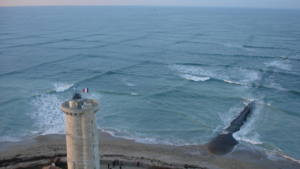Physical Address
23,24,25 & 26, 2nd Floor, Software Technology Park India, Opp: Garware Stadium,MIDC, Chikalthana, Aurangabad, Maharashtra – 431001 India
Physical Address
23,24,25 & 26, 2nd Floor, Software Technology Park India, Opp: Garware Stadium,MIDC, Chikalthana, Aurangabad, Maharashtra – 431001 India

CLAIM
The appearance of square waves on the surface of the ocean means a tsunami is on its way and one must get away from the water
FACT
Square waves in the ocean can be dangerous, but they aren’t a means of predicting tsunamis. They are formed as a result of two strong currents from opposite directions colliding in the water.
WHAT THEY SAY
Posts resurfacing on social media platforms from time to time claim that if anyone observes square waves in the ocean, they must get away from the water immediately as it is a signal of an incoming tsunami wave.
Here is one such post :
WHAT WE FOUND
When water from different weather systems or from two seas collide in the oceans, something like a criss-cross or chessboard pattern gets formed on the surface. Different weather systems colliding occur when a wind sea and a swell, or two swell systems coexist and is fairly common in the ocean.
This phenomenon is called a cross sea or a square wave which was once believed to be a tsunami warning but not anymore. Cross seas also often occur in the coastal regions, e.g. generated by wave refraction and diffraction. Unlike normal circumstances when waves run parallel to the shore, a cross sea is when the waves of one weather system run at an oblique angle to another weather system which continues moving ahead in the same direction despite facing strong resistance from the opposite current.
Such waves, which can be similar to rip tides in intensity can be found in the ocean as well as near the coast. Though considered very rare to spot in other places, these waves frequently occur at a spot near La Rochelle in France where tourists climb atop a lighthouse to witness the phenomenon.
Are cross seas dangerous?
Reportedly, cross seas have caused a number of shipwrecks over the years. Waves can go upto 3 metres high which is enough to overturn or swamp small vessels and the overlapping currents are strong enough to pull swimmers down. During the course of a study on cross seas, many ship accidents took place when fast temporal variations of sea state parameters were observed around the time of the accidents. The study also states that for most of the cases, accidents occurred during crossing sea conditions, or just after crossing sea conditions, when the swell and the wind sea were just almost aligned.
How can Tsunami be predicted?
Britannica defines a tsunami as a catastrophic ocean wave, usually caused by a submarine earthquake, an underwater or coastal landslide, or a volcanic eruption.
Scientists cannot predict the time and location of the next tsunami, just like they cannot forecast earthquakes that generate most tsunamis. But scientists know which earthquakes are likely to generate tsunamis and can issue alerts accordingly when they think waves of such magnitude may occur.
Warning centre scientists quickly detect and analyze earthquakes and observe and measure tsunamis with the aid of information about earthquakes and tsunamis collected from seismic and water-level networks from around the world. However, nonseismic tsunamis which arrive with little to no warning are difficult to forecast.
Natural tsunami warnings usually include one or more of the following and these phenomena mean that a tsunami could be arriving within minutes. These warnings are strong or long earthquakes, a loud roar from the ocean, and unusual ocean behaviour, which can be of two types. The two types of unusual ocean behaviour that can help predict a tsunami naturally are, firstly, the ocean could look like a fast-rising flood or a wall of water. The other behaviour is that it could drain away suddenly, showing the ocean floor, reefs, and fish like a very low, low tide.
Square waves or cross seas aren’t listed as one of the natural tsunami warnings on any reliable site. But getting caught in such currents can be dangerous not only for swimmers or surfers but also for sailors.
Cross seas Image source: Wikipedia / Michel Griffon